Sarāḥ Phalcā, Patan

One of the most distinct and yet often overseen rich and lived architectural elements of Newari intangible and tangible heritage is the Phalcā (Newari) or Pāṭī (Nepali). It is an arcaded platform with multiple functions for everyday social gatherings; like a space for the elderly to meet and spend their leisure time or to play cards, read newspapers. Pāṭīs are also used for religious purposes, such as playing bhajanas (devotional songs) on auspicious days and distributing ritual food such as samaybaji, during chariot processions. Once a new chariot is constructed, fragments of the old one are placed in front of pāṭīs and worshipped.
The history of the phalcā goes back to the Licchavi period, but their use, and presence has changed over time, and with socio-spatial, demographic dynamics. Whether it is endangered by encroachment or demolition, or cherished and recently even rejuvenated, primarily depends on the community that is responsible for the phalcā. Though partly endangered, the phalcā is not on its 'way out’. Even today, communities invest in the construction of new pāṭīs.
Sarāḥ Phalcā stands out for its remarkable pillar carvings. Located in Ikhachen (Ikhācheṃ), to the east of Tapahiti, the original name of the Phalcā is Sadāvarta Phalcā, most likely because it was constructed under the Sadāvarta Guṭhī of Śreṣṭhas from Ikhachen. There is no evidence to date its initial construction. However, relying upon the woodcarvings of the monument, it appears that the pillars were constructed during the late Malla period. Until the early 2000s, there was a library in the Sarāḥ Phalcā. The Phalcā's suffered severely in the 2015 earthquakes. The roof was removed and renovation work was initiated in November 2019. However, this initiative came to a stop and the Phalcā deteriorated further.
For more information about Sarāḥ Phalcā, please visit DANAM.
